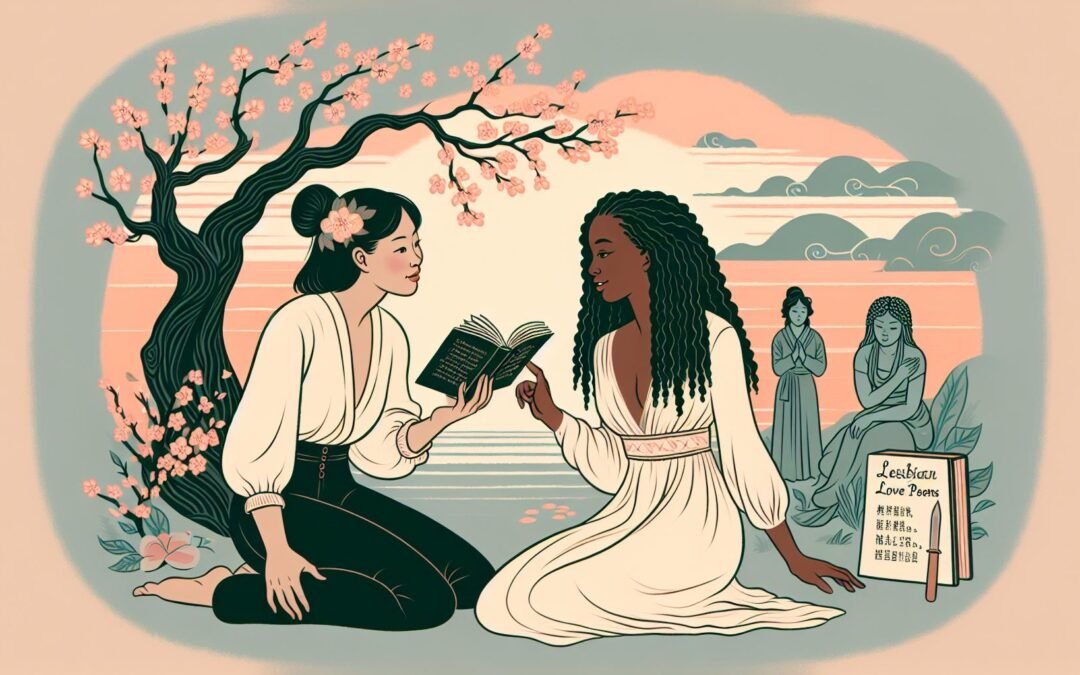Lesbian love poems trace a lineage defined by resilience, innovation, and a shifting interplay between voice and silence. From the earliest Greek lyric fragments to the fractured forms and luminous imagery of the twentieth century, their history weaves intricate ornaments of coded language and poetic form, consciously crafted for furtive or distant audiences. Scholars explore how these works exist as a palimpsest, where erasures amplify meaning and the persistence of affection across time is both miracle and method.
Historical Currents and Foundational Voices in Lesbian Love Poems
In antiquity, Sappho’s surviving poems evoke sensuous immediacy through tactile detail and vivid apostrophe, capturing the beloved’s lips, eyes, and gestures. Although only fragments remain, her lyric are a vital touchstone for all later explorations of desire between women. The poetry of Sappho is inherently bound to practices of communal performance on Lesbos, referenced in critical biographies of Sappho and pivotal to understanding classical literature’s navigation of same-gender love. Ancient authors and compilers frequently distorted her reputation, sometimes reframing her as a schoolmistress dedicated to moral instruction, other times as little more than a mythic figure distanced from desire. The consequences of male-controlled transmission meant that poems had to traverse centuries of censure, translation, and mythologization before reaching modern readers.
During the medieval period, lesbian desire reshaped itself within courtly allegory, mystic literature, and hagiography. Cloistered women authored devotional texts where language of spiritual longing and bodily intimacy blur. These texts (epistolary poems, spiritual allegories, and cautiously erotic hagiographies) reveal how affection could exist between devotional sisters while still navigating prohibitions. In vernacular poetry from southern France, female troubadours occasionally depicted yearning for the unattainable, their voices cloaked in formal innovation and ambiguous pronouns. The Renaissance heightened lyric ambiguity: Shakespeare’s gender-fluid plays and the sonnet cycles of Sidney and others permitted subversive readings, though most canonical works restricted desire between women to inference or indirection. Female poets like Vittoria Colonna addressed real or imagined women in a register balanced between admiration and encrypted longing.
The Victorian and early modern eras witnessed shifts in the poetic possibilities available to women expressing same-gender attraction. Emily Dickinson’s letters and lyrics to Susan Gilbert thread coded signals (shared metaphors, private pet names, elliptical references) throughout her epistolary verse. Michael Field’s sonnets give voice to mutual eroticism through classical echo and rich intertextuality, and their innovative dual authorship unsettled prevailing categories of gender and individuality. In fin de siècle France, Renée Vivien and Natalie Clifford Barney championed unapologetic expression, producing poems suffused with classical references and Sapphic allusion, while their salons fostered an environment for fearless experimentation. Poets H.D. and Amy Lowell layered Hellenistic myth, personal emotion, and radical form, contributing to modernism’s emphasis on subjective eruption, ambiguity, and the electrifying force of image and cadence.
Law and social convention demanded subterfuge, fueling a subtle repertoire of concealment in lesbian poetics. Violets, the Moon, and private gardens formed a lexicon of secrecy. Censorship altered or suppressed original texts; ambiguous translations and editorial glosses displaced explicit feeling, especially in Sappho’s lyrics and Michael Field’s diaries. Recovery projects and anthologies began to reconstruct this suppressed tradition, highlighting previously erased poets and surfacing semantic traces embedded in metaphor, image, and address. Layered language became simultaneously shield and signature, with minute gestures of intimacy marking entire constellations of meaning. These adaptations find resonance in contemporary compilations of rhyming poetry about love and forms that maintain coded undertones while engaging wider audiences.
Sappho’s Enduring Influence and Lineage
Sappho’s corpus shimmers with tactile immediacy and precise emotional register. Her address to “you,” intimate yet elliptical, fashioned a template for lyric intensity and plurality. Later poets reworked Sappho’s language to assert connections to an ancient, feminine provenance, styling themselves as inheritors of a suppressed erotic wisdom. Mary Barnard’s crystalline translations and Anne Carson’s masterful fractured renditions, as discussed in major studies and modern editions used in university syllabi, have propelled Sappho’s voice to the center of dialogues about gender and eros. Every major period of lesbian poetry reckons with the reality that translation (across language, genre, and identity) remains both wound and opportunity. These reception histories reveal piercings of textual absence by the urgent presence of desire.
Major Themes, Motifs, and Codes of Expression
Focus on desire transforms ordinary language and the lyric form into vessels for rapture, ache, and anticipation. Poems gather their emotional force through highly specific imagery: the scent of a wrist, a tensioned silence, a pressed palm. The yearning in lesbian love poems often resides in the spaces between speech, in hesitations that reveal internal struggle and the costs of longing. Anticipation and memory cohabitate—the before and after of contact, the recursive attention to what cannot be safely said aloud. These inflections are visible in wider movements of romantic poetry, where celebration and secrecy entwine.
Forbidden love enlivens the smallest action with risk and revelation. Secret meetings, encoded glances, and rituals of concealment become dramatic subjects in their own right. Imagery of veils, shadows, locked gardens, and twilight evokes continual negotiation between self-expression and outward silence. Many modern poets employ the architecture of night, hidden spaces, handwritten notes, and mythic allusion to maintain deniability while gesturing toward forbidden realities.
Through these challenges, poems also explore fractured identity and self-discovery. The lyric speaker’s “I” oscillates between self-reckoning and address to another woman, yielding a sense of multiplication, interruption, and emergence. These moments of coming-into-voice underpin the development of queer subjectivity. Poets frequently mount an interior drama where names and categories become unstable, vocabulary expands or fails, and love configures a new self.
Natural imagery codes intimacy and transformation: lilies, gardens, water, fruit, and moonlight serve as keys for encounters that resist definition. Myths (Artemis, Aphrodite) and stories of transformation are recurring and functional, enabling circumvention of banned language while connecting the individual to cosmological narratives. Personal objects, tokens, and small keepsakes, such as ribbons or lockets, accrue talismanic significance, mediating memory and binding absent beloveds.
Form, Technique, and Poetic Innovation
The “incantatory lilt,” unanticipated silences, and breath-caught moments infuse lesbian poetry with urgency. Patterns of enjambment or ellipsis, the deliberate use of pause, and vulnerability in vocal address reveal layers of emotional flux. The poem alternates between invitation and withdrawal, producing a tension that matches the emotional realities under censure.
Persona functions as both mask and theater stage. By writing as heroines, mythic figures, or invented selves, poets multiply storylines and destabilize unitary subjectivity. Polyvocal texts generate a chorus of “I” and “you,” dismantling boundaries between the individual and a larger community or tradition. Direct address in pleas, confessions, or dialogue with ghosts invites complicity, forging a space where language itself stages desire.
Innovation infuses structure: the sonnet, villanelle, or ode becomes pliable. Poets invert rhyme patterns, warp meter, or introduce fragments suspended in open form. Free verse creates flexible rhythms that mimic the quickening or hesitation of yearning. Hybrid forms (prose poems) encapsulate transformation, accretion, and fluctuation. Contemporary anthologies document experiments where collage, visual poetry, or other genres become expressive analogues for love’s multiplicity and defiance. Related forms, such as ghazal and haiku, allow further innovations captured in resources on types of love poetry.
Intertextuality constitutes an active force in lesbian lyric. Citation and echo create networks of kinship, summoning literary foremothers as mentors, rivals, or companions. Poems reference Sappho, H.D., Dickinson, or contemporary figures as a means of historicizing desire, mapping lineage, and destabilizing the notion of fixed identity. Layers of allusion shift temporality and context, situating personal emotion within community and collective memory.
Notable Works and Canonical Figures
Sappho’s fragments, celebrated for charged address and tactile image, remain unmatched in their ability to convey concentrated feeling and a cosmos of relation in a single sentence. Later practitioners drew upon her template, even as suppression and myth surrounded her legacy. Renée Vivien’s poetry recasts the possibilities of gender and myth in effusive modern French lyric, while Michael Field’s experimental cycles anticipate later queer formal invention.
In American poetry, Emily Dickinson’s enigmatic, compressed lines enact secrets through syntax. H.D. weaves myth, psychology, and eros into imagistic lyrics that invoke ancestral memory and cosmological force. Poets in twentieth-century traditions found in these exemplars a resource for inventions of their own, producing cycles and books that helped shape what would be recognized as lesbian love poems: Adrienne Rich’s “Twenty-One Love Poems,” Audre Lorde’s passionately political erotics, and Judy Grahn’s celebrations.
Major anthologies and critical editions continuously transform the landscape, salvaging neglected figures and challenging received genealogies. Through the archiving of letters, diaries, and alternative genres, expanded definitions of poetic subjectivity and intimacy reshape understandings of lyric tradition. For contemporary poets and readers seeking to experience these expressive evolutions, curated collections on best love poetry books provide essential reference points.
Forms and Future Possibilities
Lesbian love poems maintain a continual dialogue with formal traditions, adapting classic structures and inventing new ones. Sonnet coronas, prose poetry, fragmented lyrics, and visual formats all serve as vessels for expressing desire, memory, and critique. Today’s poets draw inspiration from this rich lineage, reshaping inherited motifs to meet the needs of new identities and audiences. The creative impulse toward visibility, invention, and connection continues to press lyric poetry beyond previous boundaries, making lesbian love poems a living field of literary artistry.

